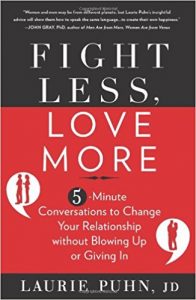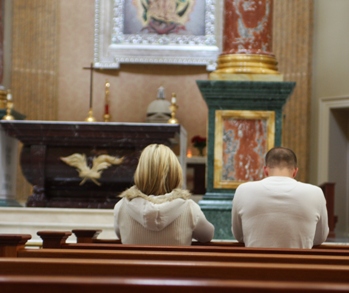In an often quoted and often misunderstood section of the letter to the Ephesians, St. Paul begins a passage about wives and husbands with these words: Be subordinate to one another out of reverence for Christ. (Eph 5:21ff)
In the late fourth century, St. John Chrysostom suggested that young husbands should say to their wives: I have taken you in my arms, and I love you, and I prefer you to my life itself. For the present life is nothing, and my most ardent dream is to spend it with you in such a way that we may be assured of not being separated in the life reserved for us . . . I place your love above all things, and nothing would be more bitter or painful to me than to be of a different mind than you. (Homily on Ephesians 20,8).
John captured well Paul’s teaching that wives and husbands are to be subordinate to one another: in other words, they are to consider the other’s good as of greatest importance, they are to sacrifice for one another as Christ himself has done, and as a couple they are to see themselves as subject to Christ. The concept of mutual subordination is a way of expressing the particular kind of love which characterizes Christian marriage, which is a union of loves so complete that the two become one.
In the Roman Catholic Church, it is ordinarily understood that husband and wife are ministers of God’s grace and confer on one another the sacrament of matrimony by declaring their consent before the Church. They are chosen instruments of God in one another’s lives–and not just the day of the wedding, but until death do us part. They are literally to help one another get to heaven! Moreover, their vocation entails not only being one in love for each other, but also being God’s instruments as a couple, most especially instruments of his creative power in giving life to children. Their love looks beyond itself and seeks to raise up new lives.
These two meanings or values of Christian marriage–the unitive and procreative–are intimately, inseparably linked; they cannot be divided without affecting the couple’s spiritual life and compromising their marriage and the future of their family. In fact, if a person enters marriage with the deliberate intention to exclude children from the marriage, the consent is invalid. Just as the persons of the Trinity are fruitful in love for one another and in creation, so the love of husband and wife is intended to be fruitful in love and offspring. Married couples are cooperators in the love of God the creator and are, in a certain sense, its interpreters.
Being cooperators and interpreters of the creative love of God carries both extraordinary joys and extraordinary responsibilities. An especially intimate and personal responsibility of every couple is making decisions about the regulation of births. Just as the crown of creation was human life, so the supreme gift of marriage is a human person, and the vocation of husband and wife entails honoring this capacity of their love with special care.
The Church does not teach that couples should have a certain number of children, but it does offer teaching about responsible parenthood, which can be summarized in these five points:
1. Husbands and wives have a responsibility to understand and honor the wisdom of the body, including its biological processes.
2. Humans share certain instincts and passions, and Christians are to guard and control them through reason and will.
3. Taking into consideration the physical, economic, psychological and social conditions of their marriage, couples exercise responsible parenthood by a prudent and generous decision to raise a large family, or by a decision (for serious reasons and made according to the moral law) to avoid a new birth for the time being, or even for an indefinite period.
4. Responsible parenthood has its roots in the truth about right and wrong established by God, and spouses have a duty to inform their consciences and make decisions according to this truth. Husbands and wives recognize their duties toward God, themselves, their family and society, and are called to maintain a proper set of priorities.
5. Offering their marriage in discipleship to the Lord Jesus, couples do not make purely arbitrary or subjective decisions regarding becoming parents but use the wisdom of God as their guide. As in every other aspect of their lives, Christian couples always remain open to God’s wisdom and providence regarding family life, including the size of their particular family. Since God brought them together and shares his love with them, he will always guide them along paths that are best for them.
Interwoven among these aspects of responsible parenthood is the understanding that the two great meanings or values of marriage — the unitive and procreative — are never separated. A love that is complete and faithful, a love which holds nothing back from the other, will remain open to Gods creative plan. After all, it is God’s love in the first place.
About the author
Most Rev. J. Peter Sartain is the Archbishop of Seattle.
This article is part of a six-part series first published for the Arkansas Catholic, a publication of the Diocese of Little Rock. It is reprinted here with permission.
Copyright © 2011, Natural Family Planning Program, United States Conference of Catholic Bishops. All rights reserved. Permission is granted to reproduce in whole or in part, in print and/or electronically, with the following statement: Last Name, First Name of Author, “Title,” NFPP/US Conference of Catholic Bishops, Washington, DC: USCCB, 2011. Used with permission on dev19.foryourmarriage.org.



 Do you and your mate get into the same arguments, time and gain? Do you encounter family members who have the uncanny ability to push your buttons and get in your face, even though you set out to steer clear of strife? As a lawyer and couples mediator I have observed the same dumb arguments ruining relationships. In my book
Do you and your mate get into the same arguments, time and gain? Do you encounter family members who have the uncanny ability to push your buttons and get in your face, even though you set out to steer clear of strife? As a lawyer and couples mediator I have observed the same dumb arguments ruining relationships. In my book 

